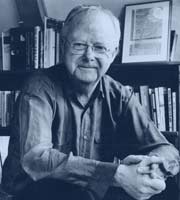Andriessen interview on La Passione

Louis Andriessen in interview about his new work, La Passione, premiered at a festival of his music at the South Bank Centreiin London in October 2002.
How did you come across the poetry of Dino Campana?
Co-incidentally, it started at a performance of another Passion, Sylvano Bussotti's La Passion selon Sade, when I first heard Cristina Zavalloni performing and I asked if I could compose for her. Our first collaboration was Passeggiata in tram America e ritorno, and in that work the sound of her non-classical voice combined with a "trembling" violin with strings gave me the idea for a longer work. She introduced me to the impressive Canti Orfici (Orphic Songs) by Dino Campana (1885-1932) and in La Passione. I set a selection from these poems in prose form.
What attracted you to the poetry?
Well, like the poems of the Dutch poet Lucebert or the films of Peter Greenaway there is a certain intellectual approach to text, often expressed through collage techniques. This interests me. Campana is a weird mixture of Futurist and Symbolist and there is an urban feel that I like. His poetry also describes psychological states he himself experienced. All his life he was a troubled, nervous person who at that time would have been described as a neurasthenic. After a five-week stay in a mental hospital in Imola his father sent him to Argentina to recuperate and this adds a certain South American flavour to his writing. He returned to Europe and was declared psychologically unstable and spent the last 18 years of his life in a clinic near Florence. The Orphic Songs describe the fall of the poet as a person, yet there are moments of visionary clarity when he asks "Why do I suffer?". So my work is in many ways about Campana's own Passion.
Are there any connections with Bach's Passions?
Not overtly. Certainly there is not a reinterpretation of baroque sound as in Writing to Vermeer. However the violin paired with the singer has a certain obbligato function as in a baroque aria. It shadows the voice in a diabolic way exploring the threatening nature of much of the poetry, like the world of a Bosch painting. Campana talks about the Devil being in your mind and I wanted to explore this in the writing for Cristina Zavalloni and Monica Germino, so it is a bit like a double concerto.
How does your soundworld reflect the poetry and its period?
I wanted to use a scoring that connects with the time around the first world war, for instance the sort of archaic modernism you can hear in the music of Alfredo Casella. There's wind with some dark doublings, brass, a collection of keyboards, plucked and hammered instruments including cimbalom and guitars, plus a violin section divided into three. Campana published his Canti Orfici in 1914, and there is a strong autobiographical link with that time. My last song is called Il Russo which tells of a fellow inmate in the mental institution. On his way back from Argentina the poet was arrested at the Belgian-French border and was detained at a psychiatric hospital in Tournai, where he observed the mental and spiritual suffering of a Russian violinist. It was during springtime in Flanders, set in a landscape of Gothic towers – it was here that Campana had a moment of self-awareness of his own condition.
What is the vocal style in the work?
I've always been interested in early music and vocal techniques that are a long way from 19th century opera, so I favour a legato, senza vibrato style. Cristina Zavalloni is experienced as an improvisor and is a vocal actress who communicates the narrative strongly. She has a casual approach to the music that attracts me - unlike many conservatoire-trained voices. Both the voice and the violin are close miked and this means the listener can be drawn closer in. It allows me to explore whispering interchanges between them.
How is the work's material organised?
There are six songs that run continuously and the piece as a whole lasts 26 minutes. I've tried to create a sense of instability to match the subject matter, not just with contrasts between the songs, but even a volatility within each song. For this reason Stravinsky's Agon was an important reference work for me in the beginning and, like that score, La Passione opens with a fanfare that sets up the unreliability of language. This start is balanced at the end by the longest and most essential song, Il Russo, similar in function to Der Abschied in Mahler's Das Lied von der Erde.
Does the work relate to your future plans?
I'm planning another piece with Cristina Zavalloni, this time a music theatre work for Amsterdam and Berlin in 2003/04. It is about the Assyrian goddess Inanna, and will consist of spoken text and music. The work also allows me to collaborate again with film-maker Hal Hartley who has agreed to write the text.
Interviewed by David Allenby
Boosey & Hawkes has collaborated with the SBC on a new CD-ROM exploring Andriessen, his music and his influences through video, audio, text and games. For your free copy of the CD-ROM please email Boosey & Hawkes.
> Further information on Work: La Passione
Andriessen photo: © Francesca Patella
